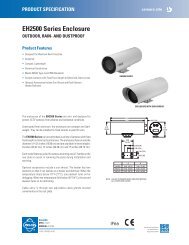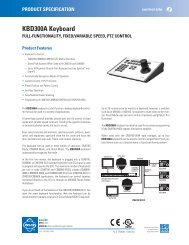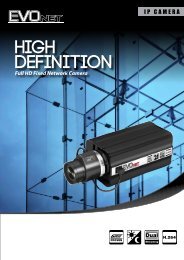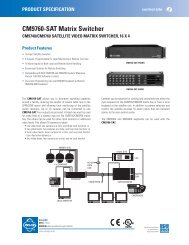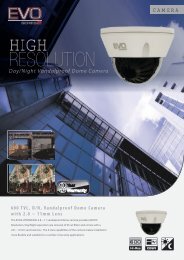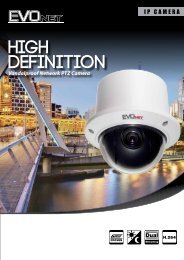Chapter 1 - Pacific Communications
Chapter 1 - Pacific Communications
Chapter 1 - Pacific Communications
Create successful ePaper yourself
Turn your PDF publications into a flip-book with our unique Google optimized e-Paper software.
User’s Manual<br />
• Event Sound: Set up to sound by playing back an audio file when an event is detected. Select a desired<br />
event and set up an audio file (.wav) by clicking the button. Clicking the button allows you to test<br />
the sound by playing back the selected audio file.<br />
• Event Spot: Video from the event-detected camera is displayed on the event spot screen when an event<br />
is detected.<br />
− Event monitoring dwell: Set up the duration for video to be displayed on the event spot screen.<br />
− Minimum monitoring dwell: Set up the event monitoring dwell time for the current event when other<br />
events are detected while event-detected video is displayed. Video from other events is displayed after<br />
the preset time expires.<br />
Network<br />
• Use buffering for live Mega-pixel images:<br />
Displays images on the screen more smoothly<br />
by using buffering when monitoring mega-pixel<br />
video images (supported only for devices which<br />
use the SiRiS protocol). Buffering may be<br />
delayed or real-time monitoring may decrease<br />
depending on the network environment. This<br />
function is supported only in a dual-core CPU<br />
or higher systems for up to four cameras in each<br />
Live panel.<br />
• Live image no frames detect interval: Set<br />
up the interval to check video frame transfer<br />
from a device to the NVR system. A message<br />
will be displayed on the camera screen when<br />
no video frame is transferred during the period.<br />
• Disconnection Message: Allows you to<br />
change the text of the screen message which is<br />
displayed when a device is disconnected. Click<br />
the Setup button, check the box beside each<br />
message and change the text.<br />
• RTP Incoming Port Range: Set up the port range if a device which transmits images using the RTP<br />
protocol is registered. Port range settings must be changed if the network firewall or local network allows<br />
only specific UDP/RTP port numbers. The port numbers should not conflict with the RTP port number<br />
of the NVR system or port numbers of other streaming programs. If an RTP port number conflicts with<br />
others, monitoring may not be available.<br />
• Don’t display broken frames: It is possible that frames will be broken or lost when using the RTP protocol<br />
depending on the network environment. Select whether or not to display the broken frames in Live or<br />
Play panels.<br />
• Buffering Frame Count: Set up the number of buffering frames to use for the RTP protocol. The higher<br />
the number is, the less the video stutter. The lower the number is, the higher the real-time monitoring.<br />
• Use Network Keyboard: Allows you to control the Client program by using a network keyboard.<br />
Set up the port number that the Client program will use when it is controlled by a network keyboard.<br />
Selecting Use large mouse cursor enlarges the mouse cursor size.<br />
38






